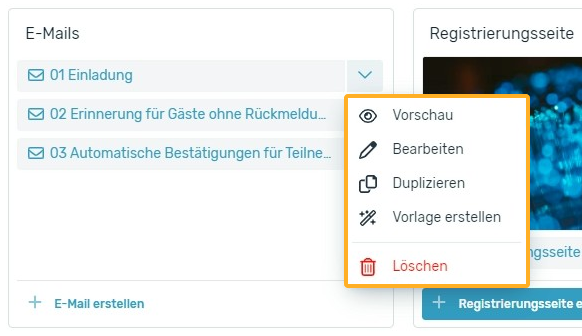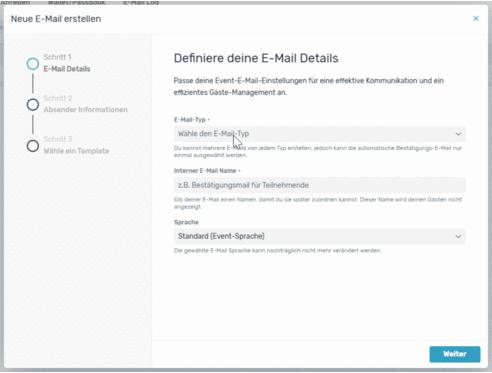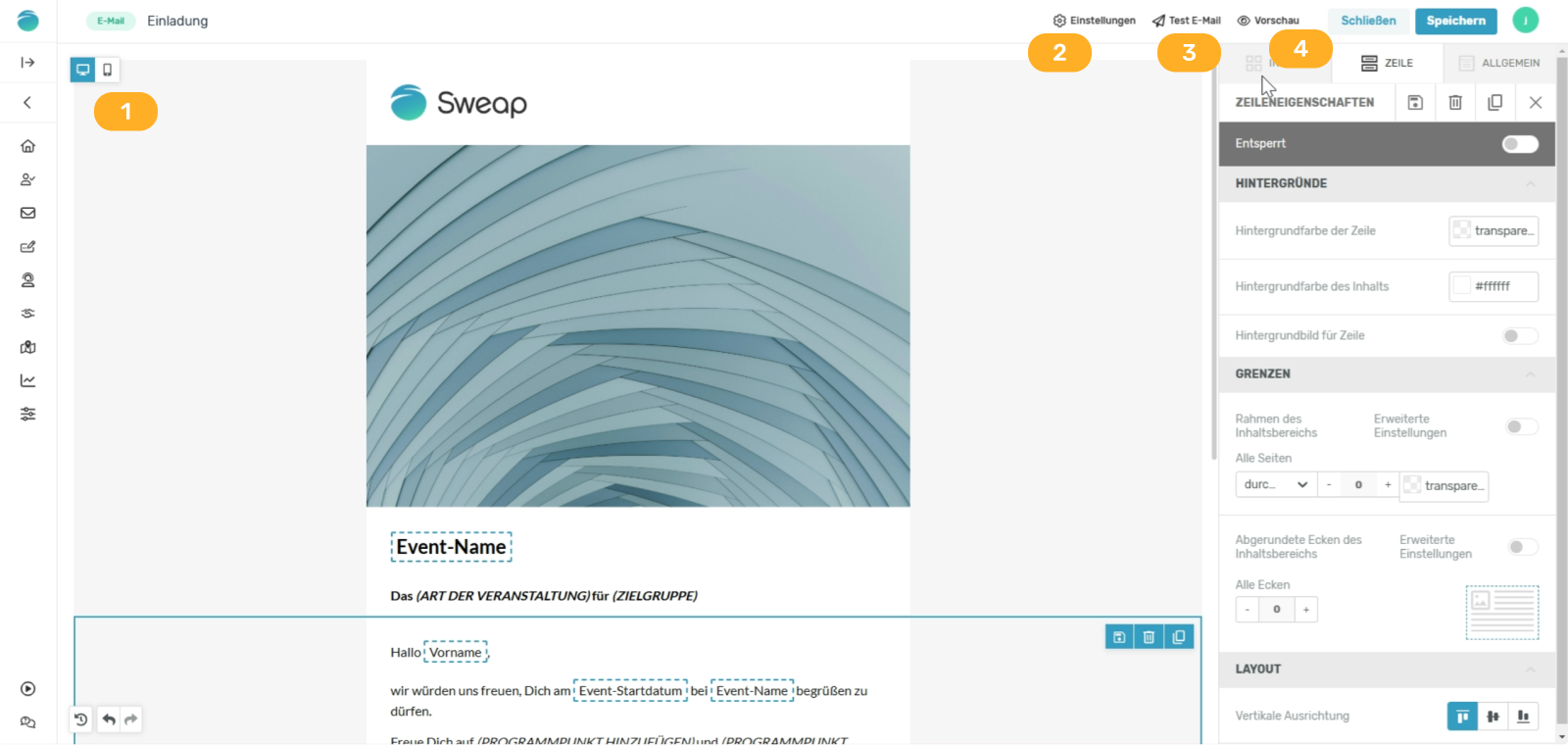Sweap set up for admins
Account setting
Administrator's guide to setting up your account
General account settings
Enable AI Feature
The event tags - creation and usage
Create guest fields for your account
Adding deletion rules to automatically delete guest data
Set up templates
User roles and permissions
Permission sets - Default user roles in Sweap
Permissions and configuration of default permission sets
User permissions and their functions in Sweap
Setting up new users
Use single sign-on
Roles and permissions
Visibility groups
Event-Ticketing - e-payment with Sweap
API and publishing package function
Implementing the event overview page within your website
Implementing the event overview page in an IHK24 website
Use Sweap's Zapier integration
Import of distributors with EVA
Import groups and committees from EVA master data
Sweap app and devices for check-in
Set up domain and email address
Getting started with Sweap - Basics
Event overview and dashboard
Basic structure of the event overview
The action field and its functions
The calendar view for your events
The event dashboard - overview
Event Sustainability Widget
Basic functions
Event formats in Sweap
What are event series?
Single event creation with Sweap
Create event series in Sweap
Create sessions for your event series
Using time zones in Sweap
Duplicate an event to use it as a template
The preview mode for creating emails or webpages
Using the correct image sizes
Create text with the HTML-Editor
AI feature in use in HTML editor
Use placeholders in Sweap
Customize headlines and text with HTML
Linking emails and websites in Sweap
Legal notice and privacy policy
Support and data protection at Sweap
GDPR-compliant consent management and cookie banners
Data tracking with Sweap
Privacy policy and GDPR
Questions about security & data protection
Sweap AI - Questions about security & data protection
Increasing security - introduction of Keycloak
Session limits - session limitation
Send your feedback about Sweap
Personal settings
Search and filter functions
The search function in Sweap
Using the filter function in Sweap
Last Update and Last Reply of your guests
Best practice, online webinars and updates
Create and manage contacts and guests
Create, import and export guest information
Add guests to your list
The guest import with Excel
Edit guest information and change status manually
Export your guestlist
Create and manage contacts
Add companions
Manage attributes for guests and divisions
Standard Fields and Event-Related Information in the Guest List
Create and edit attributes
Segmenting guests by categories
Postal mail invitation and QR code
Setting up and sending emails
Setting up and configuring emails
The email types and their use
Create mails more efficient with using the duplicating function
Testing emails in the editor: Here's how it works
Individual salutation
The guest salutation
Create guest salutation with our salutation assistent
Use your own salutation form in your emails
Dynamic email builder
Dynamic email builder: Create emails
Guest-Links and Token: Efficient Event Communication
Configure emails using a dynamic modular system
Design your email - Content
Design your email - Rows
Design your e-mail - General
Email wizard
The different types of email templates
The Email template LA LUNA
Static email wizard: creating emails
Configure emails - set up an invitation email
Call to Action Button withinin emails
Insert links for virtual events into emails
Insert stock photos into emails
Font types in emails
Troubleshooting for emails
Opt-In states and bounces
Reduce spam probability of emails
Display images correctly in my email
Delivery notification and bounces in the email log
Basics for the successful delivery of emails
Tracking email opening rates
Important information about blocked email addresses - status "mailjet: preblocked
Sending out emails
Registration pages & Virtual event platform pages
Registration page basics
Creating a registration page - basic steps
Metadata and SEO for registration pages
Deactivate event pages (URL link tracking)
Registration page - using the Website Builder
Registration page - using the websitze wizard
Templates for your webpage
Contents and modules of a registration page
Texts, colours and design for the registration page
Settings to close the registration page - Website Wizard
Registration options settings within the Website Wizard
CSS & Java Scripts for website customisation
Header and footer within a website
Publish events on your own website
Font types on websites
Setting up the registration form
Configuration of a registration form
Add a checkbox with URL to the registration form
Show and hide form fields
Enter accompanying persons (registration form)
Virtual Event Platform
Integrations and modules for the Virtual Event Platform
Operate and monitor events with Sweap
- All Categories
- Setting up and sending emails
- Dynamic email builder
- Dynamic email builder: Create emails
Dynamic email builder: Create emails
 Updated
by Julia Walther
Updated
by Julia Walther
In this article, we explain how to create a new email with our dynamic email builder.
Creating an email
You can create an email both via the dashboard and via the “Communication” section.
Dashboard
Open the dashboard of an event. In the “Emails” card, select the “+ Create email” button.

You will also find our quick menu in the email card in the dashboard. The following functions are available to you via the quick menu:
- Email preview
- Edit email
- Duplicate email
- Create a template from the email
- Delete email

"Communication” area
Open the Communication section and click on the “+ Create email” button.

Configure email
Regardless of whether you create your email from the dashboard or via the Communication section, you will first be taken to our dialog box for configuring your email.

Step 1 - Define your email details
Define the following points in the first step:
- Email type
- Internal email name
- Language
Step 2 - Customize sender information
Define the following points in the next step:
- Sender email address
- Sender name
- Email subject
- Reply email address
Step 3 - Template selection
In the last step, you select your template. Use the previously selected email type as a guide for template selection.
You can choose between the Sweap template and our La Luna template. The templates already take into account the email type you have previously selected, so that all the necessary standard components are built in for you.
Click on “Create” and you will be taken to our dynamic email builder. With the flexible modular system, you can now give free rein to your creativity and design your emails to suit your needs and taste.

- Our email builder offers a live preview - you can track your changes directly.
You can switch between a desktop view and a mobile view. This allows you to optimize your email for mobile reception as soon as you create it. - You can further configure your email under “Settings”.
Among other things, you can adjust the internal email name or the previously stored sender information.
The advanced settings can also be found here, where you can, for example, link the associated registration page. - Test your email by sending yourself a test email.
- Use the additional preview mode.
You can find detailed information on creating emails here. (link to new detailed article).
